You’re already saving money and gaining a profit by using dropshipping, but did you know you can augment your earnings even more by incorporating affiliate marketing?
It’s true!
The synergistic potential between dropshipping and affiliate marketing is off the charts. You can rely on affiliate marketing to expose your brand to new audiences, convert more customers, and elevate your sales.
I’m sure you’re chomping to get started. I don’t blame you.
In this blog post, we’ll explore various dropshipping affiliate marketing programs, as well as the benefits, steps, and more.
Let’s get started.
Table of Contents
Key Takeaways
- Using affiliate marketing in dropshipping can be advantageous, exposing your business to new audiences and increasing revenue.
- Aligning your affiliate goals with your business objectives strategically is the key to success, as is continually assessing and adapting strategies for maximum mutual benefit.
Basics of Affiliate Marketing in Dropshipping
Affiliate marketing is a program between two businesses or one business and one individual. An affiliate produces content, be it written or video content, and posts it online. They will link to your affiliate products in their content.
When a shopper clicks the link to purchase the product, the checkout process is straightforward and normal for them. However, the customer helps the affiliate earn a commission by shopping through the affiliate link. Your dropshipping business makes money through sales.
Okay, so those are the basics. Next, let’s dive deeper into affiliate marketing by reviewing its key components.
Niche or industry
Most affiliate marketers must select a niche from scratch, but not you. The affiliate niche you’d enter would be related to the products you sell, which will create the most cohesiveness.
Affiliates
An affiliate is the business or individual you enter an affiliate partnership with. You provide them with your products, which they make promotional content for. Their content goes online, people purchase your products, and the affiliate makes their commission.
You end up with more customers and income.
Most affiliates are content creators, influencers, or bloggers, but there are also affiliate marketing platforms catered toward dropshipping businesses. Some of them are Dropship.Me, Shopify, and Dropified.
Content
The content produced in an affiliate marketing arrangement drives more people to your eCommerce store. It can include blog posts informing the audience about what your product does, how it’s made, or how it works.
Other examples are sharable infographics, short eBooks, and video content unboxing and demoing the product.
Merchant relationships
A merchant relationship is the partnership between your dropshipping business and the affiliate. You’d act as a merchant, while the influencer or content creator is the affiliate.
Commission structure
You and your affiliate must assemble your heads to determine which commission structures best suit your working relationship.
Recurring commissions
Recurring commissions set up a long-term partnership between the merchant and the affiliate. Each time referred customers make a recurring payment, the affiliate receives a cut, expressed as a percentage.
A popular usage of this commission structure is if you offer monthly subscription services. The affiliate could receive 25% of the subscription sales.
Tiered commissions
As the name alludes, a tiered commission depends on the affiliate’s level of success if they want to earn more money. In other words, they get a base commission rate that steadily increases with the more orders they move.
You might offer them 10% for 10 sales and 30% for 50+ sales.
One-time commissions
Although this sounds like a shorter-term working arrangement, it isn’t necessarily. Instead, a one-time commission is a pricing model where the affiliate makes a specific, predetermined amount for every order.
The fixed amount does not take into account the price of the order. So, for example, if you two agree to a fixed rate of $35, and you sell a T-shirt for $35, the affiliate takes all. However, if you sell an $800 item, they only get $35.
Percentage-based commissions
Lastly, there are percentage-based commissions. These operate like one-time commissions, but rather than a dollar amount, the affiliate receives a fixed percentage of the sale each time they refer customers to your dropshipping business.
Read also: Affiliate Marketing — A Complete Guide for SaaS Businesses
Advantages of Integrating Affiliate Marketing with Dropshipping
Although initially, combining dropshipping and affiliate marketing will take more time and possibly require more money, the advantages make it worthwhile.
Here are the benefits of unifying the two business models.
Cost-effectiveness
How often have you entered business arrangements with another party where you paid for their potential instead of their performance?
It’s a great deal for the other side, as they get paid no matter what, but if you’re only paying for what you hope will become results, not what will materialize, you can undercut your profits.
You won’t have those concerns when you add affiliate marketing to your dropshipping business plan, especially if you select a performance-based commission structure like tiered commissions.
Paying for performance ensures your affiliate is motivated to continue selling, which provides a steady stream of revenue for your business. You’ll also enjoy an influx of leads, which will further pad your bottom line if you convert most of them.
Expanding market reach
How much money have you spent on marketing and advertising for your dropshipping business? However much it is, you have to continually add up those costs over the life of your dropshipping business model.
While you can’t do away with your advertising and marketing strategies entirely, you might be able to reduce your reliance and more effectively control your costs by implementing an affiliate marketing model.
Working with different affiliates exposes your dropshipping business to many unique and diverse audiences you would otherwise have to spend thousands of dollars connecting with through ads and marketing campaigns.
Your only fee is the affiliate commission rate, making it a win-win.
Enhancing brand credibility
Are you trying to build a dropshipping brand in a crowded industry or niche market? Look into affiliate marketing. Partnering with reputable affiliates makes your brand more trustworthy by default. After all, if you were shady, why would this affiliate (or any other) want to work with you?
Affiliate marketing can help put your eCommerce brand on the map, building awareness, trust, and loyalty.
Read also: 17 Affiliate Marketing Programs That Bloggers Should Not Miss
How to Set Up an Affiliate Program for Your Dropshipping Store
What goes into establishing a successful affiliate program? Here are the steps your dropshipping business should follow.
Step 1: Choose the right affiliate platform
The first step is also the hardest, as there are so many affiliate platforms out there geared toward dropshipping companies. I listed a handful of them before, and I will recommend my favorites a little later.
It only takes a quick Google search to see all the options, but which are right for your business? Let’s look at some considerations to help you narrow your options:
- Reputation: Reviews are there for a reason, to help you make a purchasing decision you’re confident in. If the affiliate platform or service has a terrible reputation, working together means proceeding at your own risk.
- Support: You’re doing your audience a disservice if you can’t reach your affiliates when needed. A platform should have a lasting legacy of quality customer support and service, giving you plenty of options to connect immediately.
- Commission structure: The commission structure selected between dropshipper and affiliate should be mutually agreeable and beneficial.
- Target audience: If there’s no connection between your desired target market and the affiliate platform audience, working together makes no sense. You won’t achieve enough of your business objectives.
Step 2: Determine your commission rate
Selecting the right commission structure is only half of it. Next, you must decide what you’ll pay the affiliate via their commission rate.
You don’t want to give them so little that no one will agree to want to work with you, but then again, if you pay them too much, you will lose out on revenue.
I recommend reviewing market standards and your profit margins to determine the most sensible rate.
Step 3: Develop promotional materials and resources for affiliates
Your affiliate will produce content, but you need to give them guidelines and resources to make your brand appealing to their audience. Promotional materials and specs will help the affiliate have all the facts so they can present your products well.
Read also: 60 Superb SaaS Affiliate Marketing Programs for 2024
Recruiting and Managing Affiliates
Now that your affiliate program is ready, your dropshipping business can move on to recruiting affiliates. Check out how it’s done and how to manage multiple affiliate partners.
Strategies for recruiting effective affiliates
Good affiliates don’t grow on trees; you must find them using these tactics.
- Browse affiliate directories: Affiliate directories categorized by niche or industry will shorten your affiliate search. You can discover new potential partners and possibly even their contact information.
- Connect with your contacts: Tap into your existing network of internal colleagues and external partners, past and present. Ask if they’ve tried affiliate marketing in dropshipping or know anyone who has, and ask which affiliates they recommend.
- Attend events: Networking doesn’t only occur online. Although it’s maybe a bit old-fashioned these days, rubbing elbows with people in the real world at expos, conferences, and trade shows can help you connect with affiliates or people who may know them.
Best practices for managing affiliate relationships
Once you have an affiliate, you and they must strive to maintain a professional relationship. If this is your first foray into affiliate marketing as a dropshipping business, don’t miss these pointers for keeping that relationship healthy.
Make your expectations clear
You have certain expectations tied to this affiliate marketing opportunity, as does your partner. Both parties should be upfront about what they want and expect so you can be on the same page.
You might want to consider producing a written policy outlining your expectations (and vice-versa). Having everything in writing can offer you legal protection if the worst happens and you end up in court against your affiliate. It won’t have to resort to a battle of he-said, she-said.
Prioritize regular communication
The best way to ensure you and the affiliate talk often is to schedule regular check-ins, such as every Thursday or every other Wednesday. Try to meet at around the same time. By building these conversations into your schedule, you won’t double-book yourself and put your affiliate on the back burner.
Read also: 7 Best AI Affiliate Programs to Supercharge Your Hustle
Update them on everything important
Do you need to touch base with your affiliate over anything and everything? No, of course not. However, they should be kept in the loop if something critical with the business partnership happens. You’d want them to do the same for you.
Provide training if necessary
There may be a bit of a learning curve at the start of your working relationship, which is to be expected. Creating a successful affiliate marketing relationship is a meshing of two business minds and styles, so there are some stumbling blocks to get past.
That’s why you might consider offering training to your affiliates to gear them up for what’s to come, including what they can say about your brand and products and what they can’t.
Monitoring affiliate performance and ensuring compliance with brand standards
The most important part of a successful dropshipping and affiliate relationship is monitoring the affiliate’s performance.
If their posts don’t reach their predicted audience numbers, that means bad news for you. There will be fewer people who will buy your products, not to mention fewer leads. It’s worth learning why an affiliate’s content has underperformed so it doesn’t happen again.
Sometimes, it’s just a rare blip, but if performance fluctuations happen often enough, you might rethink whether to continue the relationship with the affiliate.
Another consideration while evaluating performance statistics is whether the affiliate is continually meeting your brand standards. If they aren’t, that could be another reason to give them the boot.
Read also: 17 Affiliate Marketing Programs That Bloggers Should Not Miss
8 Best Affiliate Marketing Programs for Dropshipping
Are you ready to start using affiliate marketing programs for your dropshipping business? Of course, you are. Here are some suited for eCommerce companies, with an overview of their features and pros and cons.
1. Amazon Associates
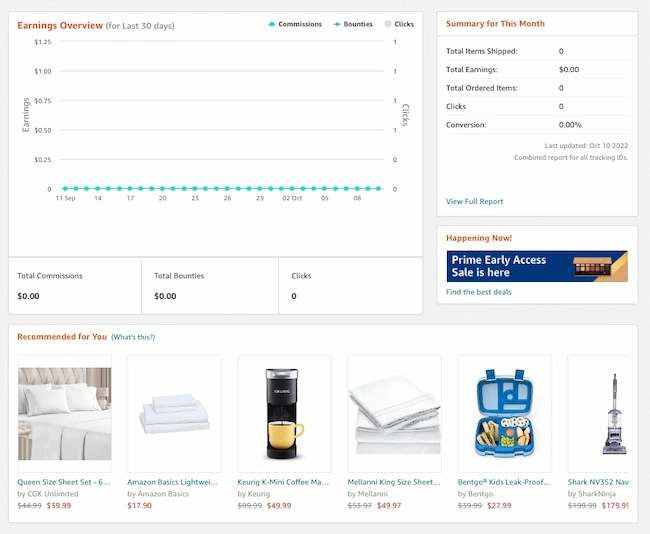
What better platform to try affiliate marketing than the retail giant Amazon? Amazon Associates is its affiliate marketing platform for bloggers, publishers, and content creators, with tens of thousands of members.
Joining is easy and free; you only need an existing Amazon account to start. The product range accepted under the Amazon Affiliate Program is millions, and the platform even offers custom tools.
Benefits
- It’s easy and free to use.
- The associate commission rate is 10%.
Drawbacks
- Amazon says its affiliate program is not designed for influencers (because it has its own Influencer Program), limiting its audience.
- Payments are delayed for up to 60 days the month after earning the commission, so it can take a long time to see any money.
2. eBay Partner Network
Almost as popular is eBay’s Partner Network, which offers two billion product listings to 132 million buyers across 190 markets. That includes global audiences, proving eBay’s gargantuan reach.
Features
- Boost revenue: Build webpages, promote your ongoing events or deals, and generate traffic to make your foray into affiliate marketing more successful.
- Many page types are supported: The eBay Partner Network lets you create brand pages, product pages, category pages, search results pages, promotional events pages, and deal pages to promote your products right.
- Analytics: Track the success of your affiliate marketing campaign using eBay’s built-in, detailed data.
Benefits
- A reporting tool makes staying on top of your latest affiliate marketing numbers easy.
- Data Feeds are available to help you scale up when the time comes.
- You can create ad campaigns within the eBay Partner Network.
Drawbacks
- Some of the features are heavy on the coding to make them work.
- Cookies expire in 24 hours, limiting the amount of affiliate revenue available to be earned for each product recommendation.
Read also: Affiliate Marketing 101 for eCommerce Business Owners
3. ClickBank
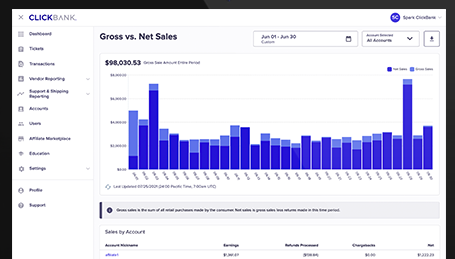
With over five million customers, ClickBank is an affiliate marketplace and eCommerce platform. It has more than 100,000 active affiliates, with brands like ShipOffers and Disk.com using it. ClickBank has paid over $6.2 billion in commissions, proving it’s a popular platform.
Features
- Education: Are you still learning this whole affiliate marketing thing? That’s fine. ClickBank has an education database you can rely on, oh, and training too!
- Analytics: The numbers come in and update in real-time so you can gauge how your dropshipping affiliate marketing program is progressing and whether you need to make changes.
- Support: The high-level support features instill confidence that you can always get help when needed.
Benefits
- Members can attend exclusive events and opportunities, such as networking events.
- The payments are reliable, so you’re not waiting forever to collect your money.
Drawbacks
- There are fees for sellers and marketers using ClickBank.
- ClickBank might penalize you if you don’t sell products for too long or if you let your account sit inactive.
Read also: How to Choose Dropshipping Products to Sell Online in 2024
4. Shopify
Is there a bigger network for building your dropshipping affiliate marketing program than Shopify? This major eCommerce platform lets you refer Point of Sale Pros for $500 each, or you can refer merchants to join the Shopify Plan and make money that way.
Of course, that’s only scratching the surface.
Shopify offers fixed-bounty commission structures and tracking tools. It’s easy to sign up, as you only need an active website with an audience and original content. You should also be experienced in eCommerce platforms, although not necessarily Shopify.
Benefits
- Shopify is free to join and is available globally.
- Shopify Affiliate Program members can use its third-party tracking software to manage affiliate referral links and review audience data.
- The tracking cookies last for up to 30 days.
Drawbacks
- Although you can apply to join the Shopify Affiliate Partner program, there’s no guarantee Shopify will approve your application.
Read also: How To Find Reliable Dropshipping Suppliers: A Quick Guide
5. CJ Affiliate
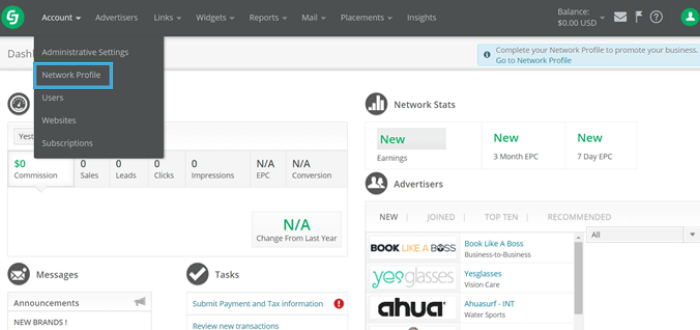
Declaring itself “the world’s largest and most established affiliate marketing network,” CJ Affiliate has an audience of one billion monthly and 14 billion active users. Its affiliate revenue levels have surpassed $16 billion.
The global platform is used by major brands such as Intuit TurboTax, HelloFresh, BuzzFeed, CNN, Blue Apron, Klarna, Bed Bath & Beyond, Barnes & Noble, J.Crew, and Office Depot.
Features
- Scalable: Between the pipeline, data, and solutions-based system, you can create an omnichannel dropshipping affiliate marketing program based on category, channel, and consumer data.
- Integrations: Onboarding doesn’t have to cause stress when using CJ Affiliate. You can connect your eCommerce business fast to begin reaping the system’s rewards.
- Partnership recommendations: CJ Affiliate will recommend partnerships based on your brand message so you can connect with your target audience via affiliates and continue scaling growth.
- Insights you need: Make and confidently pursue affiliate marketing decisions based on data such as journey touchpoints and perceived consumer value.
Benefits
- CJ Affiliate has a robust system that offers all the assistance, solutions, and resources you need to build your dropshipping affiliate marketing program.
- Discover more of the partners you need, from influencers to agencies and all top brands, with this tool.
- The customer support is top-notch.
Drawbacks
- There aren’t as many payment platforms supported as you might hope, with PayPal being the most conspicuous in its absence.
- The commission rates are inconsistent across the board, as some may be higher and others lower.
6. JVZoo
The free affiliate marketing platform JVZoo simplifies selling, letting you do it from one account. The program lets you sell any products you want with unlimited quantities available, and you can choose from a variety of payment processors, including Authorize.net, BlueSnap, Stripe, and PayPal.
Features
- Easy recruitment: All you need to do to maximize JVZoo is upload a list of your products. Then, you can begin seeking and recruiting suitable affiliates within the network.
- Payment variety: From profit sharing to auto-affiliate and recurring payments, you have plenty of options to ensure you get paid.
- Two-tiered affiliate commissions: When you recruit an affiliate, you get a commission for their sales!
- Analytics: Follow specific tracking IDs, review sales by dollars or percentages, and more when JVZoo sends you regular affiliate reports. In the meantime, you can review KPIs as they come in.
Benefits
- Explore a robust library of features to take your dropshipping affiliate marketing aspirations further.
- Personalize and customize the features of JVZoo to your dropshipping business.
- Integrate JVZoo with your favorite tools, including JVZoo Pay, Payment Rails, Zapier, Payoneer, Fleep, GoToWebinar, AWeber, and Slack.
Drawbacks
- The competition on this platform can sometimes be steep.
- Not all products on JVZoo are high-quality, diluting the overall selection.
Read also: Is Affiliate Marketing Legit? Unmasking Common Myths & Scams
7. ShareASale
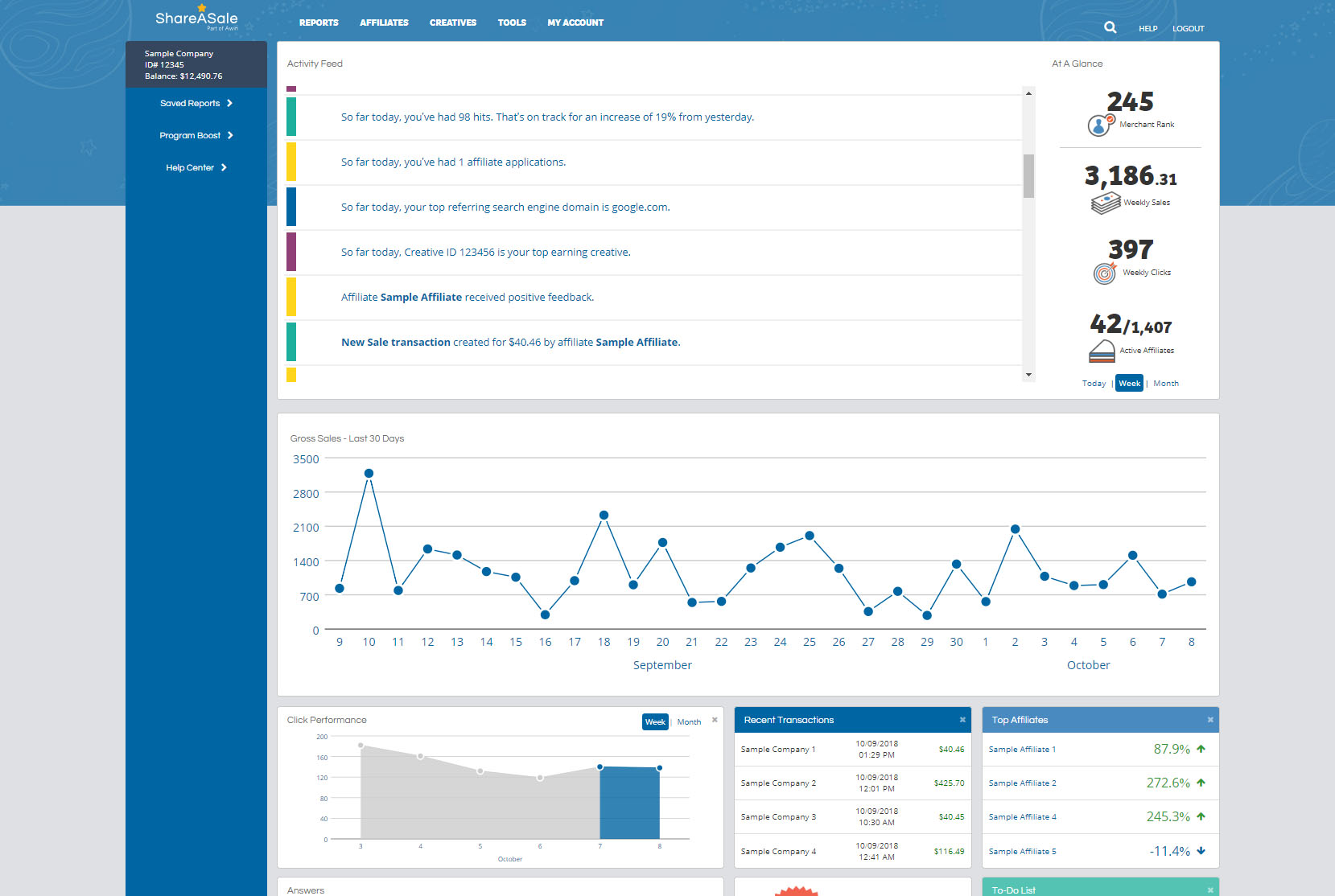
Affiliate marketing may be new to you, but not ShareASale. It’s been in this business for two decades, so it knows a thing or two about successful partnerships. Your dropshipping business can find your affiliates here, no problem.
ShareASale has features for affiliates, agencies, and merchants so you can select what suits you. I’ll focus on the merchant features.
Features
- Increase your audience: It’s easy to find your target market using ShareASale, as you can utilize tech and tools to connect with valuable partners.
- Attributions: When your affiliates do an excellent job, show them how much they mean to your online business by upping their commissions. You can customize commissions at any time.
- Tracking: Whether offline or online or on mobile or desktop, you can gain insights on specific products, coupon codes, and customers through ShareASale.
Benefits
- ShareASale has merchant features just for dropshipping businesses striving for growth.
- Customizing commissions will incentivize more affiliates to join you.
- Joining ShareASale is free for affiliates.
Drawbacks
- You can’t always find broken links, which makes them hard to remove.
- You can’t verify the affiliate links on ShareASale.
8. Rakuten Advertising
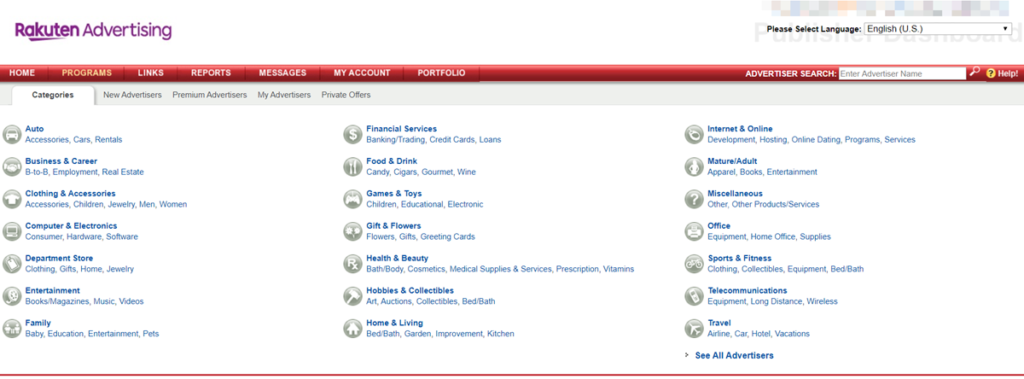
Rakuten has implemented AI into its eCommerce brand and affiliate advertising platform, proving that it’s on the cutting edge. Rakuten Advertising serves travel, retail, and financial services brands.
For more than 25 years, Rakuten Advertising has helped more than 100 in-market experts and 150,000 top-tier partners launch in under a month.
Features
- Detailed data: Identify the partners to take your dropshipping business to the next level. Then, rely on Rakuten’s data to find and solve performance gaps and other issues.
- AI-driven: Rakuten Advertising’s AI feature, which it calls Affiliate Intelligence, combines human and technology elements to further your affiliate marketing campaigns.
- Advertising: Boost your ROAS with recommended ad placements by Rakuten.
Benefits
- Rakuten Advertising has awesome support and expert teams to assist you every step of the way, including local and territorial experts.
- You can also count on Rakuten for omni-channel influencer marketing services.
Drawbacks
- The payment rates are lower on this platform than others unless you accumulate a lot of orders.
Read also: How to Build a Dropshipping Brand That Clicks
Optimization and Scaling
As your partnership with an affiliate grows (and your dropshipping business does in kind), it’s time to explore scaling up. That could involve the following:
- Growing your team: You might decide to diversify your team, hiring staff to assist with your affiliate marketing ventures as you take on new affiliate partners or expand your affiliate offerings.
- Collaborate on products: If you and your affiliate agree it’s prudent, you can create a new product together. Making it a limited edition will increase interest and sales.
- Continually learn about affiliate marketing: As the field evolves, staying abreast of rising trends in the affiliate marketing industry and how they relate to and can benefit dropshipping will make your partnerships even more efficient.
- Consider automation: Automating more tasks associated with running a dropshipping affiliate marketing program will free up your time to dedicate to product ideation, packaging, shipping, and fulfillment.
- Branch into different markets: Diversifying your product roster will make it easier to enter new markets as your affiliate relationship begins scaling upward.
- Incorporating feedback and data analytics: Reviewing the feedback you get and building upon it will improve your performance and increase the number of happy customers willing to buy your products.
Don’t forget that you should optimize your affiliate sales using techniques like these all along.
Targeted promotions
Keeping communications personalized between you and your customers will make each one feel like an individual, even though your customer ranks keep growing. Tailoring product recommendations to them, besides building loyalty, will get them in a shopping mood, as they’ll be unable to resist your fantastic suggestions.
Building on your bottom line also helps your affiliates make more commissions for each sale.
SEO for affiliate content
All affiliate content posted online should follow basic SEO rules. For instance, you or the affiliate should perform keyword research beforehand, ensuring the content touches on the right terms. You should identify a target market and a desired tone for your brand.
Continue building your brand with these strategies:
- Writing descriptive URLs
- Using alt images
- Maintaining a website loading speed of two to eight seconds
- Adding meta description to content
- Using internal links
- Building reputable backlinks
Read also: Discover What is Dropshipping and How You Can Do It
Challenges and Solutions in Dropshipping Affiliate Marketing
If dropshipping affiliate marketing were easy, everyone would be doing it. However, that’s not the case.
Difficulties will crop up regularly. Understanding your challenges and brainstorming solutions to overcome them will put your business relationship in the best position to succeed.
Handling market saturation and competition
An oversaturated market may be the future of dropshipping, as more digital buyers have entered the market steadily each year from 2014 to 2023. That was even the case during the COVID-19 pandemic, when online shopping became even more prevalent.
Keeping oneself primed for the risk of oversaturation means preparing in advance. Entering a niche market can delay oversaturation risks if you aren’t part of one already.
So, too, you can diversify your products and branch off into different audiences.
With oversaturation comes a continual wave of new competition. Again, innovating in ways that don’t put you several steps ahead. You should also prioritize good SEO, as if your site ranks higher, you’ll still get the lion’s share of traffic and sales over your competitors.
Maintaining brand consistency
It’s difficult enough for one brand to maintain consistency across its communication channels when multiple people handle social media, email, and other accounts. Once you add a second party to the mix, such as an affiliate, it becomes even trickier.
You might send them a cheat sheet or guide to your brand so they have it in front of them whenever needed.
Ensuring quality control
Likewise, a proactive approach will help your dropshipping brand maintain its quality control standards.
Check-in on all operations you’re not directly a part of. Plan this at least once a quarter or more frequently if you’ve recently had quality control issues.
Consider standardizing your quality control expectations in a rulebook to eliminate ambiguities.
Legal considerations
Affiliate marketing partnerships still must play by legal rules. For example, you must disclose the affiliate relationship on your website. You should also establish clear terms and conditions for affiliate conduct to avoid landing in legal hot water.
Read also: How to Minimize Shipping Times in Dropshipping
Conclusion
Affiliate marketing can transform dropshipping businesses, although that requires you to select the right partner and have procedures to drive success. As eCommerce strategies require continuous evolution, staying competitive through innovative marketing approaches remains critical.
EngageBay is an all-in-one marketing, sales, and customer support software for small businesses, startups, and solopreneurs. You get email marketing, marketing automation, landing page and email templates, segmentation and personalization, sales pipelines, live chat, and more.
Sign up for free with EngageBay or book a demo with our experts.
Frequently Asked Questions (FAQ)
1. What is dropshipping affiliate marketing?
Dropshipping affiliate marketing combines third-party outsourced shipping with affiliate links. An affiliate promotes the dropshipping company’s products to its audience, earning a commission for products sold.
2. How do I choose the right affiliates for my dropshipping store?
Consider areas like the affiliate’s reputation, level of service, types of content they post, commission structure, and audience as you make up your mind.
3. What commission structure should I use for my dropshipping affiliate program?
This will require a conversation between you and the affiliate to determine the most advantageous for both sides. One-time commissions might be a good starting point.
4. How can I track and measure the success of my dropshipping affiliate marketing?
Analytics tools built into your existing affiliate program will help you gauge whether dropshipping affiliate marketing works for your business. Track KPIs like email opens and click-throughs, website traffic, social media engagement, brand mentions, abandoned carts, conversions, and sales.
5. Are there any specific legal issues in dropshipping affiliate marketing?
Yes, certainly. You and the affiliate must know data protection, product safety, and intellectual property regulations and laws. You should also understand and abide by basic consumer rights.
6. How do affiliate marketers promote dropshipping products?
Affiliates promote your goods through blog posts, unboxings, in-depth reviews, and live product demonstrations.

